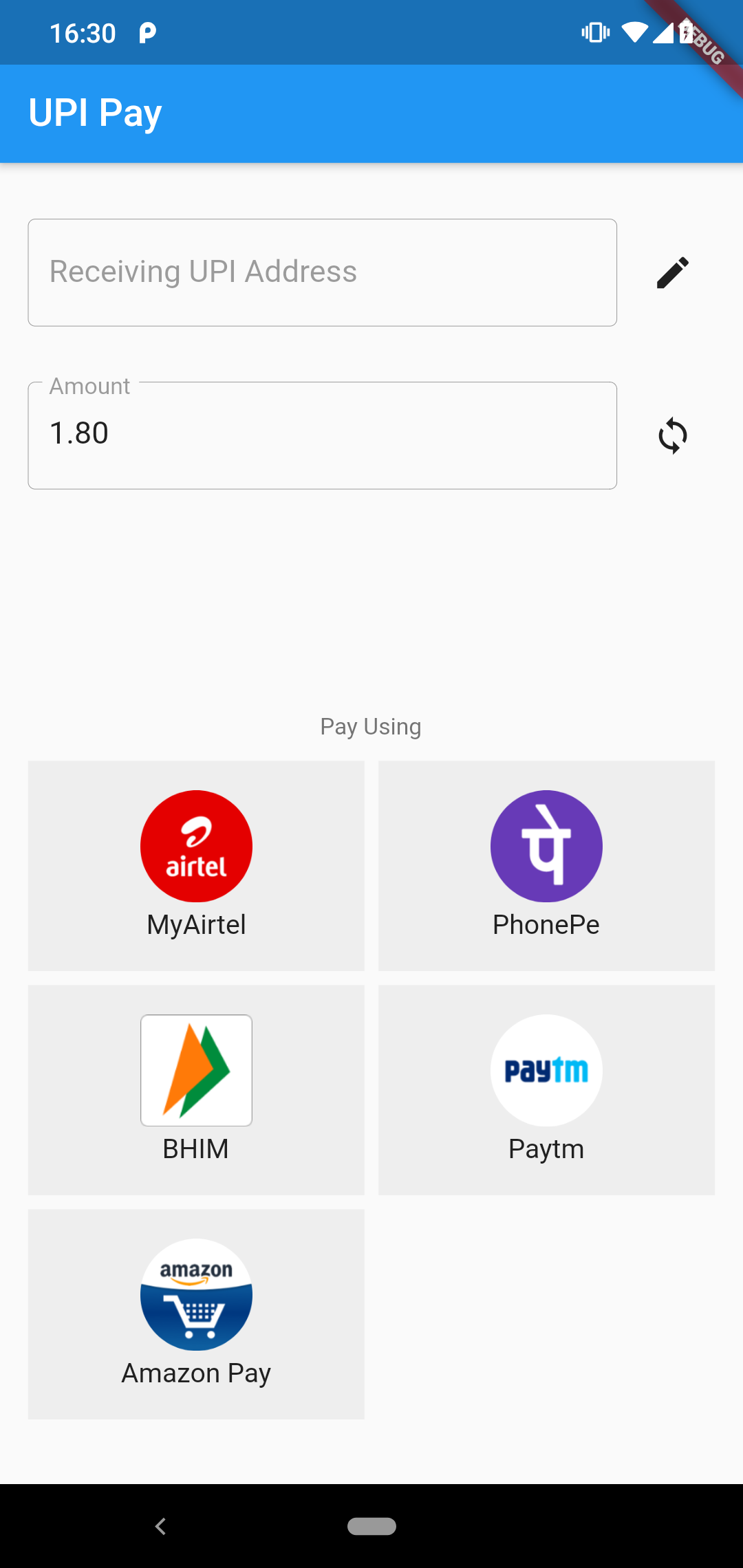upi_pay 0.2.3  upi_pay: ^0.2.3 copied to clipboard
upi_pay: ^0.2.3 copied to clipboard
A flutter plugin to make payments by opening UPI applications using Android Intent and receiving the transaction information back in response.
upi_pay (android only) #

A flutter plugin to make payments by opening UPI applications using Android Intent and receiving the transaction information back in response.
The plugin also provides additional APIs to query and list installed applications.
The plugins follows the UPI Deep Linking Specification
Getting Started #
First, add the package to your flutter project's pubspec.yaml as a dependency
dependencies:
flutter:
sdk: flutter
# adding upi_pay as dependency
upi_pay: ^0.2.0
Then, import the package where you need to use it
import 'package:upi_pay/upi_pay.dart';
Documentation #
Start a UPI Transaction #
You can call the UpiPay.initiateTransaction method to start an UPI Transaction
Method Call
UpiTransactionResponse txnResponse = await UpiPay.initiateTransaction(
/// must be a string value of two decimal digits
amount: "10.00",
/// UpiApplication class has all the supported applications
/// only accepts a value from the UpiApplication class
app: UpiApplication.payTM,
/// Name of the person / merchant receiving the payment
receiverName: "John",
/// UPI VPA of the person / merchant receiving the payment
receiverUpiAddress: "johnupi@paytm",
/// unique ID for the transaction
/// use your business / use case specific ID generation logic here
transactionRef: 'ORD1215236',
/// there are some other optional parameters like
/// [url], [merchantCode] and [transactionNode]
/// url can be used share some additional data related to the transaction like invoice copy, etc.
url: 'www.johnshop.com/order/ORD1215236',
/// this is code that identifies the type of the merchant
/// if you have a merchant UPI VPA as the receiver address
/// add the relevant merchant code for seamless payment experience
/// some application may reject payment intent if merchant code is missing
/// when making a P2M (payment to merchant VPA) transaction
merchantCode: 1032,
/// anything that provides some desription of the transaction
transactionNote: 'Test transaction'
)
Response
The response will be an instance of UpiTransactionResponse
You can access the following properties on the response instance -
-
txnId- The Transaction ID from the PSP -
responseCode- The UPI response code can be used to decipher the reason for failure (if any) -
approvalRefNo- UPI Approval Reference Number -
status- This can have one of the following status valuesUpiTransactionStatus.SuccessUpiTransactionStatus.FailureUpiTransactionStatus.Submitted
Always prefer the use of
UpiTransactionStatusenum to decipher the status of the transaction response for better code health -
txnRef- The transaction ref that was passed when initiating the payment. Use this value to identify which transaction the response belongs to
You can also access the raw URL response by accessing rawResponse on the response object
Take a look at the UPI Linking specification linked above to better understand the meaning of these fields
Exceptions
The method can throw the following errors -
InvalidUpiAddressException- if the UPI Receiver Address is not in valid formatInvalidAmountException- if the transaction amount is in invalid format (< 0 or > 1,00,000 or has more than 2 decimal digits)
Get UPI Applications #
You can list the UPI application that can handle an UPI Intent.
This API can be used to list all the UPI application on the user's device that can be used to complete an UPI transaction.
List<ApplicationMeta> upiApps = await UpiPay.getInstalledUpiApplications();
The ApplicationMeta instance has the following properties on it -
upiApplication- an instance of theUpiApplicationwhich can be passed as argument for theappparameter inUpiPay.initiateTransactionpackageName- the package name value likenet.one97.paytmorcom.phonepe.appicon- stores the icon of the package inUInt8Listformat and hence can be used to render the icon as suchImage.memory(icon, width: 64, height: 64)preferredOrder- the order of app in the UPI Intent results according to user's preference (earlier usage). This can be used to highlight the most recently used apps by the User for making UPI payments.
Example #
We have an example application in the same repo and that can be used a reference